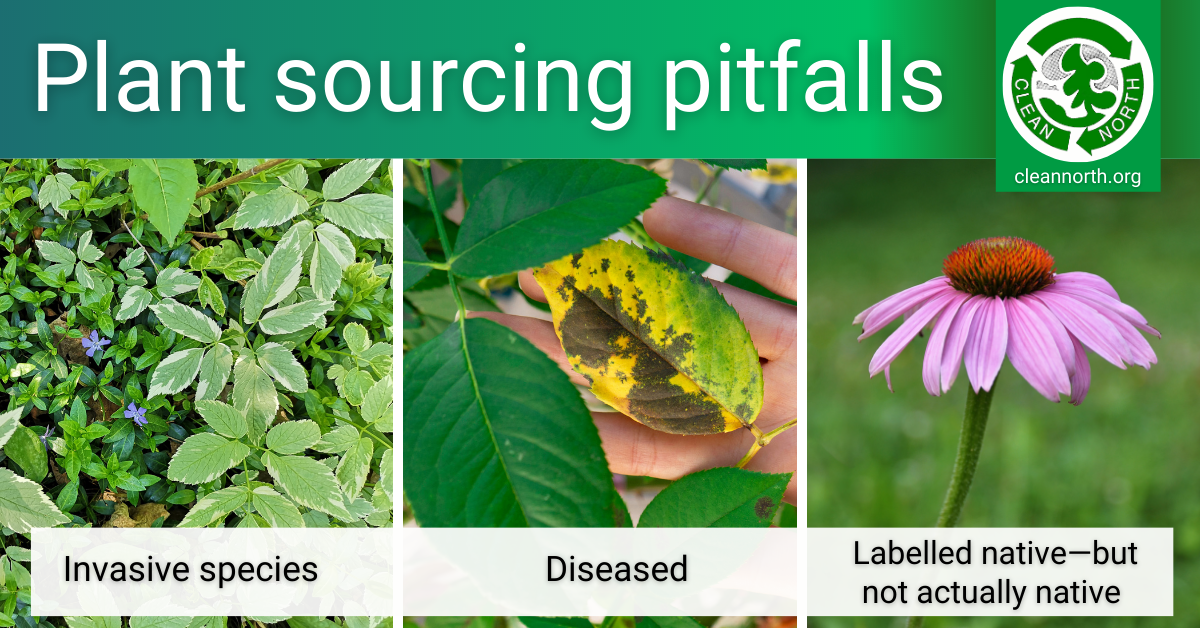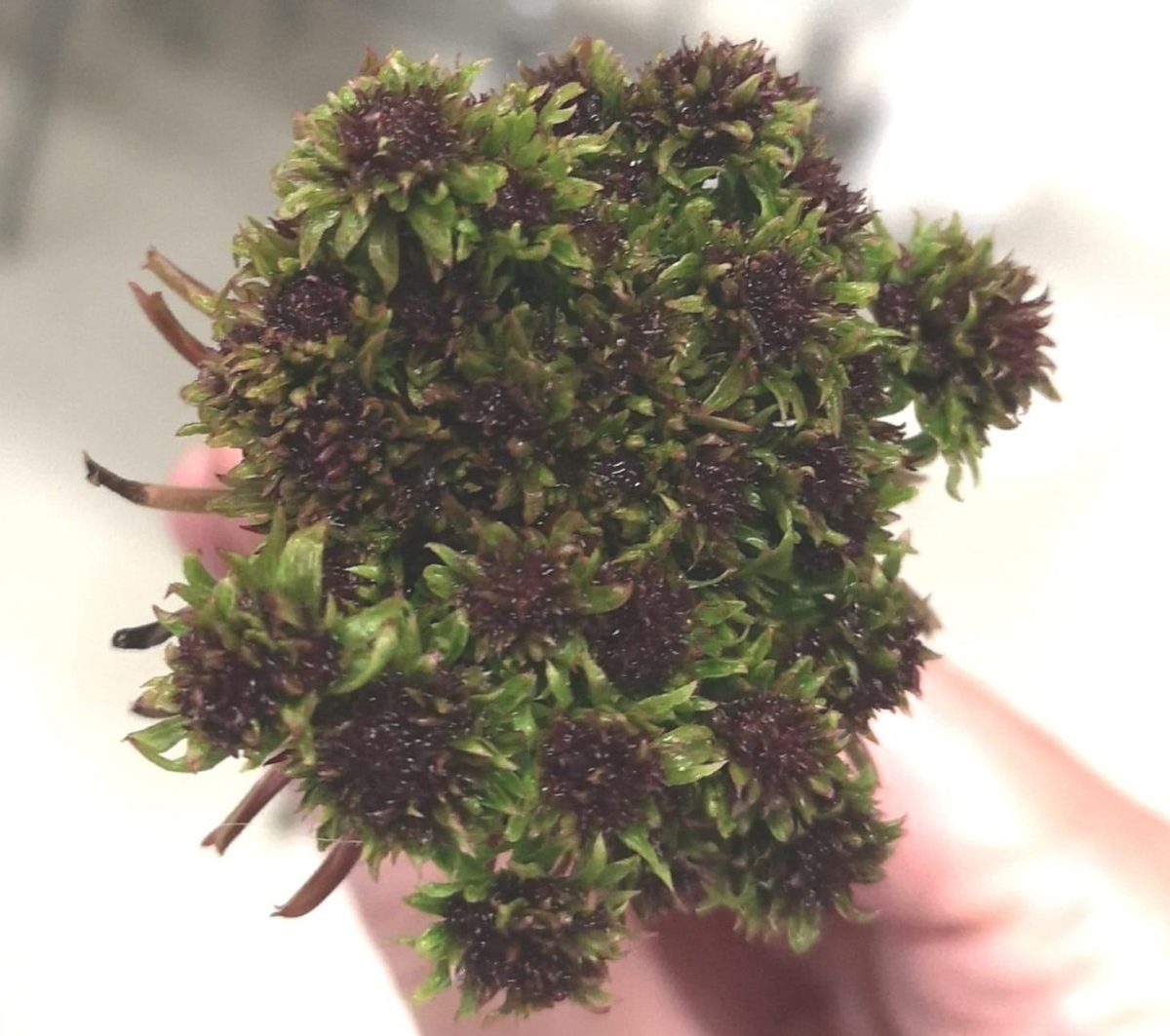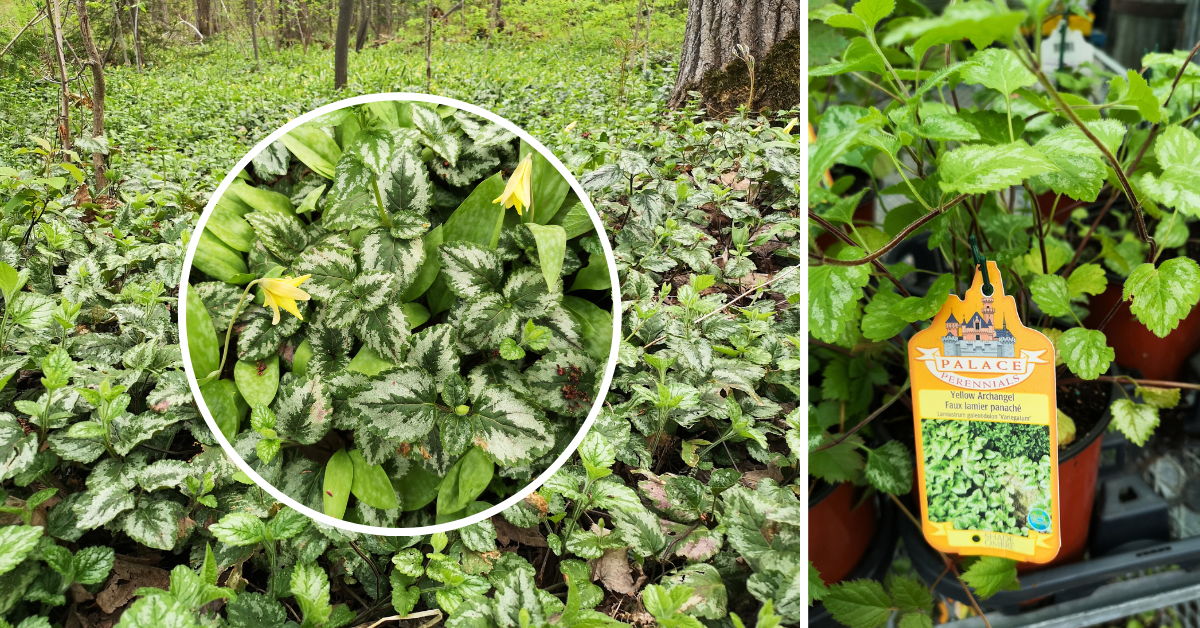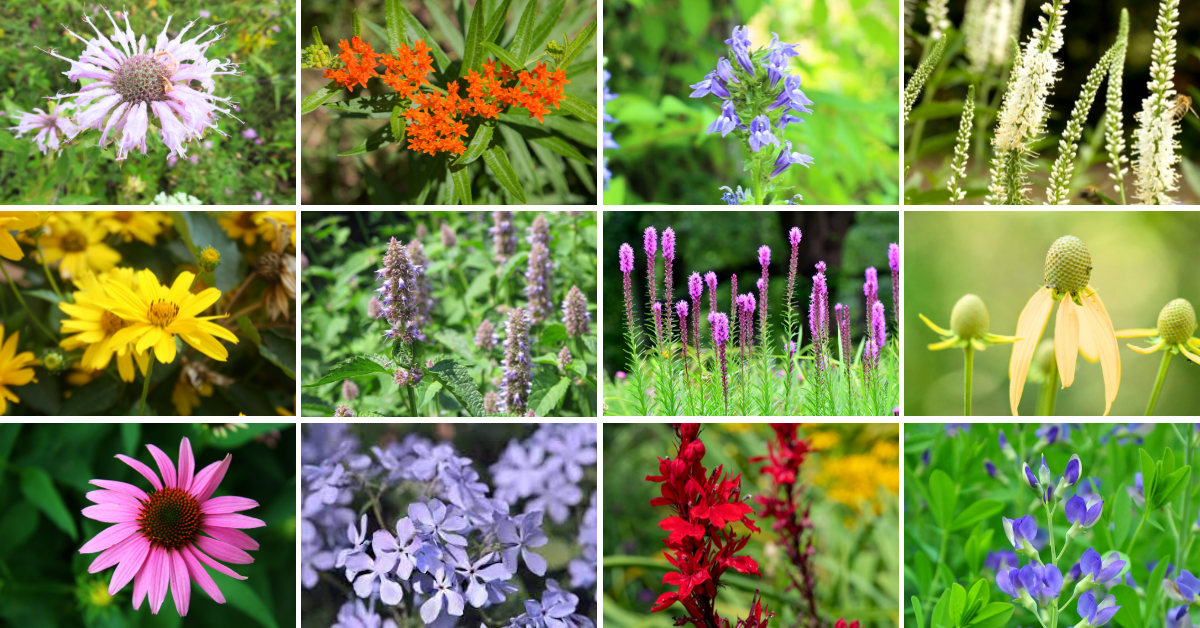
New plants can come with issues and ethical concerns. For example, buying a single invasive plant can cause your garden major harm and lead to native wildflowers being devastated in a natural area near you. So we urge all gardeners and property owners to embrace the Do No Harm motto when choosing plants. Making informed choices will help protect ecosystems, our communities, and our wallets.
Second-hand woes
Many of us have scored delightful new plants for free or low cost from the yards of friends or other gardeners in our area. Everyone loves a bargain! However, this practice is risky. Many gardeners have been burned by a pass-along plant that turned out to be an invasive species took over their entire garden bed or escaped into a nearby natural area.
Even if it’s a “good” plant (not invasive), your second-hand plant could be harboring roots or seeds of invasive species in its soil. One of our volunteers says the last two plants she was given by friends both had invasive goutweed lurking in the pot.
The soil may also contain other kinds of invaders such as jumping worms—earthworms from Asia that can destroy garden soil and create zones where nothing will grow. While these worms have not yet been detected in our area, they have been found in the Upper Midwest and southern Ontario.
So please, before you sell or give away a plant from your yard, make sure it’s not invasive (Clean North’s invasive plants list). And before you accept a second-hand plant:
- Confirm the species
- Do a thorough search to figure out if it’s invasive in Ontario or adjacent states/provinces
- Ask what invasive plants might have been growing nearby
- Consider removing as much of the soil from the plant as possible and throwing it away in a sealed trash bag or even washing the plant’s roots to make sure no tiny roots from invasive species or eggs from invasive critters are hanging on (root washing tips at bottom of this post)
Taking these precautions will help keep new invasive plant species from taking up residence in your yard, pushing out other plants you love, harming nearby natural areas, and causing you major headaches and cost to remove/control.
Diseased plants
Another pitfall with second-hand plants is disease: The plant may be sick but you may not know it because the seller trimmed off the diseased parts.
This can happen with plants sold at garden centres, too. One of our volunteers bought a tree and later realized it had signs of a potentially fatal disease. He took it back to the garden centre, and the staff person said they would just trim the diseased leaves off and sell it to someone else!
If you have a plant that’s sick, figure out what the disease or pest is. If it’s treatable, treat it. If not, bag and discard it. Please do not share diseased/pest-ridden plants. Aster yellows is an example of a disease that affects many garden plants—including some vegetables—and is not curable. Plants should be dug up, bagged, and thrown away.

Invasive plants at garden centres
Yes, many garden centres still sell invasive plants like goutweed, periwinkle, lily of the valley, yellow archangel, Japanese barberry, burning bush, false spirea, and Norway maple. And many websites that appear reputable push some invasives as being wonderful garden species. So what’s a plant buyer to do?
- Do not assume that because it’s legal to sell a given plant or a webpage praises it, it’s fine to buy it. Many damaging invasive plants are still legal to sell and are being lauded on gardening websites. Governments are not doing enough to fix this. (If this bugs you, consider signing on as a supporter of the Canadian Coalition for Invasive Plant Regulation.)
- Before you buy any plant, check to see if it’s invasive. If it’s listed as invasive anywhere in eastern North America, don’t buy it. If it’s invasive in a northern U.S. state like Illinois, Michigan, Maine, or Massachusetts, it likely can become invasive here, too.
- Be wary of the advice of garden centre staff. Some have strong knowledge of what’s invasive and what’s not. Others, not so much. Always double-check invasive status.

Non-native plants labelled “native”
Thanks to the Great Lakes being a massive physical barrier, many wild plants common in eastern North America did not historically grow in Algoma. For example, purple coneflower is not native to Algoma. It’s not even native to southern Ontario!
Unfortunately, garden centres and seed sellers are not always careful about what they label and market as native. A plant labelled native in a garden centre here in Algoma may be native here—or it may be native to southern Ontario or the northern or eastern United States. This lack of attention to detail causes obvious problems if you are looking to create an authentic native plant garden in Algoma.
While, planting most “native-adjacent” plants is generally not harmful (Manitoba maple is a notable exception), promoting plants as being native here when they actually aren’t is misleading.

- Top row, left to right: Wild bee balm, butterfly weed, great blue lobelia, black cohosh.
- Second row: Oxeye sunflower, anise hyssop, blazing star, grey-headed coneflower.
- Third row: Purple coneflower, woodland phlox, cardinal flower, false blue indigo.
Because the above species are native to the south or east of us, they likely offer benefits to the ecosystem and our local pollinators/birds/other wildlife. But if you are looking for true natives, these are not your best bets.
Also be aware that cultivated varieties of native plants can be less useful to the ecosystem than the original. Fancy ruffled columbines, for example, are more difficult for bumblebees to burrow into. Our native eastern red columbine is best for native pollinators.
So to best benefit our local ecosystems, including pollinators and birds, take time to learn what’s truly native. Seek out Algoma native species such as swamp milkweed, spotted Joe Pye weed, pearly everlasting, and trout lilies (the Sault/Algoma Grow Me Instead Guide is a helpful resource). This guideline applies whether you are buying plants or growing them from seed.
Ethical native plant sourcing
Native plants can be hard to find, but use caution when seeking them out in nature:
- Do not remove plants from parks and protected areas as it’s against the law to do so.
- Removing plants from other public land should be done with caution as it can disrupt the ecosystem.
- Never remove a plant that is endangered or threatened from any location in the wild.
- Steer clear of private land unless you have permission
It’s better to collect seed and grow native plants from seed than to remove whole plants. Be sure to follow ethical guidelines when collecting seed.
You can also buy seed but try to find a company selling seed adapted to Northern Ontario conditions (like Northern Wildflowers or The Superior Gardener). If you have a friend with rural property, they may be willing to let you collect seed.
Follow these five simple rules
- Don’t buy, sell or give away invasive plants
- Research species (especially for invasive status) before bringing them home
- Be wary of pass-along plants from friends or others in your community
- Don’t sell or give away unhealthy plants
- Consider growing more native plants—but acquire native plants/seed ethically
Questions?
Email us at info@cleannorth.org.
How to wash plant roots
- Work in the shade to minimize stress on the plant.
- Gently break up soil around the roots and shake off as much soil as possible without tearing/breaking roots. This may be difficult if the soil is super wet. If there’s a risk of invasive species in the soil, do this work inside a trash bag, seal the bag, and throw away the soil.
- As soon as you are done shaking soil, off, immerse the root ball in a pail or tub of water for at least 15 minutes. Do not allow roots to dry out! Soak larger plants longer.
- Remove the plant from the pail/tub and use a gentle stream of water from a hose to gently loosen the roots and wash soil off.
- If there’s a risk of invasive species in the soil, try to collect/bag/toss as much of the soil as possible. Avoid doing this work in your driveway as washing bits of invasive species roots or seeds into the sewer system can spread those invasives elsewhere in your community.
- If the soil is still hard to remove, place the plant back into the container of water to soak some more.
- Resume gently spraying the soil off the root ball.
- Gently untangle the roots to get at all the soil and continue spraying until all the soil is gone.
- Check the roots to make sure no other species’ roots are entangled. If you do find roots that appear to be from another plant, bag, seal, and toss.
Now you are ready to plant your new plant!




